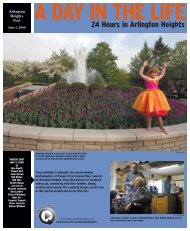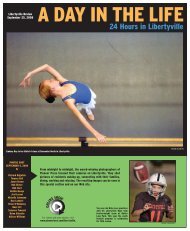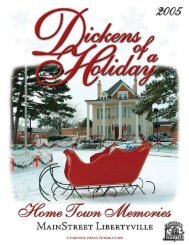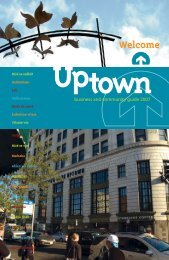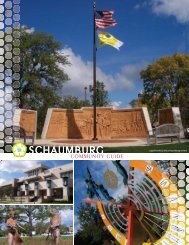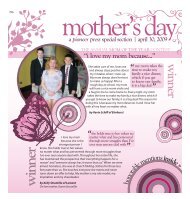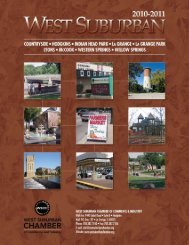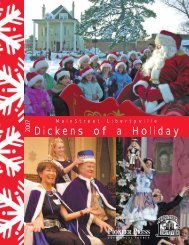2011 Glencoe Community Guide - Pioneer Press Communities Online
2011 Glencoe Community Guide - Pioneer Press Communities Online
2011 Glencoe Community Guide - Pioneer Press Communities Online
You also want an ePaper? Increase the reach of your titles
YUMPU automatically turns print PDFs into web optimized ePapers that Google loves.
Intersection of Park Avenue and Vernon Avenue Circa 1920s. - <strong>Glencoe</strong> Historical Society<br />
Archives<br />
his t o r y of Gl e n c o e<br />
gle n c o e ch a m b e r of co m m e r c e | <strong>2011</strong> co m m u n i t y gu i d e<br />
Each May, <strong>Glencoe</strong>’s second graders travel about the business<br />
district, looking at pictures of intersections at various times in history<br />
and ask what has changed over time. What was “then” and what is<br />
“now?” In fact, <strong>Glencoe</strong> may have changed over the past years, but<br />
physically, it looks similar to the town that began to grow in the late<br />
19th century.<br />
<strong>Glencoe</strong> started as an agricultural hamlet—home to farms, a lumber<br />
yard and stagecoach stop—but over time evolved into a suburban<br />
community with a local business district. Homes that were built at<br />
the time <strong>Glencoe</strong> was incorporated, l869, still stand tall today next to<br />
those built in the 1920s, 1950s, and the 21st century. <strong>Glencoe</strong> retains<br />
much of its small-town feel as the Village evolves, while holding tightly<br />
to its heritage.<br />
Native American Potawatomies were here before white settlement;<br />
they used the densely forested land for hunting. In 1835, Anson H.<br />
Taylor, storekeeper and future stage coach inn owner, moved with<br />
his family from Chicago to begin new lives. He named the area after<br />
himself, Taylorsport. It was an agricultural hamlet with a lake pier and<br />
farms plowed by English and German immigrants who joined the<br />
Taylors before the Civil War.<br />
<strong>Glencoe</strong> evolved, change spurred on by the 1855 arrival of the<br />
railroad. The station was located across from the house of Walter S.<br />
Gurnee, president of the Chicago and Milwaukee Railroad (later the<br />
Chicago and North Western<br />
and now Metra and the Union Pacific). Gurnee was a real estate<br />
speculator, as well as former mayor of Chicago. He located the depot<br />
near his holdings after Anson Taylor rejected the idea of combining<br />
railroad and stage coach stops. The town grew up around the train. It<br />
is likely Gurnee also gave <strong>Glencoe</strong> its name, after his Scottish roots,<br />
or perhaps he named the village after his father-in-law, Matthew Coe,<br />
from whom he bought the stock farm and home. (Coe’s Glen).<br />
In the late 1860s, a pediatrician idealist, Dr. Alexander Hammond,<br />
came to town and bought Gurnee’s home. Dr. Hammond’s dream<br />
was simple: he enlisted nine other men to join him in creating a<br />
utopia. Each man agreed to<br />
build a house for himself and to sell another to someone else. The<br />
<strong>Glencoe</strong> Company agreed to keep a park at the lakefront in perpetuity<br />
and to fund a church and a school. Unfortunately, the real estate<br />
declines of the 1870s put most of the <strong>Glencoe</strong> Co., including Dr.<br />
Hammond, out of business. But the village they founded, platted<br />
and incorporated in 1869 was on its way.<br />
With the railroad, <strong>Glencoe</strong> developed into a commuter community<br />
for some and a summer vacation community for others. Although<br />
there were many German farmers in <strong>Glencoe</strong>—the Diettrichs and<br />
the Beinlichs —through the Second World War, the population<br />
grew and changed, with the village becoming more suburban<br />
than rural and new residents moving in from all over—African<br />
Americans from the south and Canada, and white ethnic groups<br />
coming from Chicago.<br />
<strong>Glencoe</strong>’s downtown—or uptown as many of the older<br />
residents call it—also changed. The village never has had a huge<br />
commercial center, but it has always bustled. Originally, there<br />
were blacksmith shops and feed stores. From 1902 to 1993, the<br />
business district’s anchor was Henry C. Wienecke’s hardware<br />
store. Other stores joined Wienecke’s (Win-eh-kees). There were<br />
many grocery stores, barber shops and soda fountains, which over<br />
the years, changed to groups of cleaners, clothing boutiques and<br />
banks. After the family sold the hardware store, the Wienecke’s<br />
property changed into residential and assorted retail spaces.<br />
The population increased steadily through 1960, requiring<br />
growth in schools from a single all-village school, today’s Central,<br />
to four schools: Central, South and North built in the 1920s and<br />
West, added in the 1950s. The community built out, with the last<br />
subdivision, Strawberry Hill on the west side of town, finished in the<br />
1950s. But then the population declined, bringing the 1976 closure<br />
of West School and then in 1979, North School, later reconfigured<br />
into the <strong>Community</strong> Center, now the Takiff Center. In the early<br />
1990s, the population pendulum swung upward once more,<br />
necessitating the 1992 re-opening of West.<br />
<strong>Glencoe</strong>’s downtown lost and gained new neighbors as the years<br />
went by. The <strong>Glencoe</strong> Movie Theater, on Vernon Avenue, was<br />
razed in 1979, as was its northern neighbor, the Masonic Temple.<br />
Christophe’s, a five-and-dime store disappeared when the Harris<br />
Bank built its drive-through lane in the late 1970s, and restaurants<br />
have come and gone. The Writers’ Theatre developed in the<br />
space behind Books on Vernon and today presents drama at the<br />
Women’s Library Club.<br />
Indeed, <strong>Glencoe</strong> has changed, but held tight to its heritage.<br />
Courtesy: <strong>Glencoe</strong> Historical Society<br />
Voted Best on the North Shore<br />
<strong>Glencoe</strong>’s Full Service Custom Frame Shop and Fine Graphics<br />
• Professional Custom Framing Designed to Enhance and<br />
Preserve Your Art...One Piece or an Entire Corporate Collection<br />
• A large Selection of Unique and Stylish Ready-Made Frames<br />
• Archival and Museum Framing<br />
• Quality Graphics in Posters and Prints<br />
• Blocking, Mounting and Framing of all kinds of Needlework<br />
& Tapestries<br />
• Home Consultation (House Calls)<br />
• Pick-Up and Delivery<br />
Celebrating 37 years in <strong>Glencoe</strong><br />
668 Vernon Avenue, <strong>Glencoe</strong><br />
835-2770<br />
v i l l a g e of gl e n c o e ch a m b e r of co m m e r c e , p.o. b o x 575, 847 835 3333, w w w .gl e n c o e c h a m b e r.or g<br />
ArEA hIsTOrY 25



